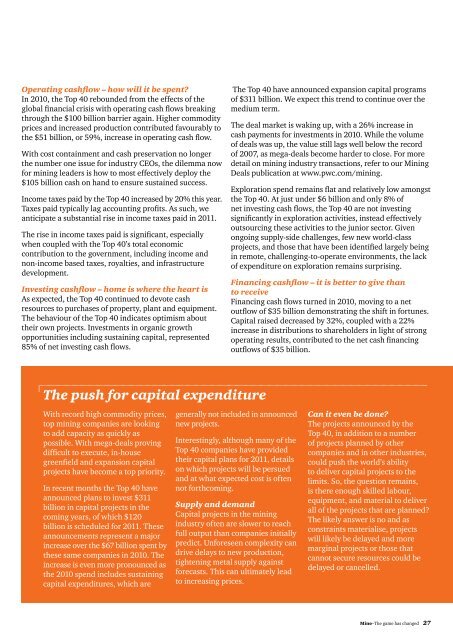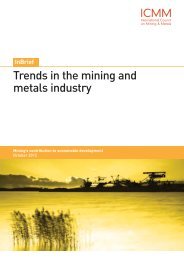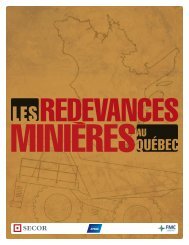You also want an ePaper? Increase the reach of your titles
YUMPU automatically turns print PDFs into web optimized ePapers that Google loves.
Operating cashflow – how will it be spent?<br />
In 2010, the Top 40 rebounded from the effects of the<br />
global financial crisis with operating cash flows breaking<br />
through the $100 billion barrier again. Higher commodity<br />
prices and increased production contributed favourably to<br />
the $51 billion, or 59%, increase in operating cash flow.<br />
With cost containment and cash preservation no longer<br />
the number one issue for industry CEOs, the dilemma now<br />
for mining leaders is how to most effectively deploy the<br />
$105 billion cash on hand to ensure sustained success.<br />
Income taxes paid by the Top 40 increased by 20% this year.<br />
Taxes paid typically lag accounting profits. As such, we<br />
anticipate a substantial rise in income taxes paid in <strong>2011</strong>.<br />
<strong>The</strong> rise in income taxes paid is significant, especially<br />
when coupled with the Top 40’s total economic<br />
contribution to the government, including income and<br />
non-income based taxes, royalties, and infrastructure<br />
development.<br />
Investing cashflow – home is where the heart is<br />
As expected, the Top 40 continued to devote cash<br />
resources to purc<strong>has</strong>es of property, plant and equipment.<br />
<strong>The</strong> behaviour of the Top 40 indicates optimism about<br />
their own projects. Investments in organic growth<br />
opportunities including sustaining capital, represented<br />
85% of net investing cash flows.<br />
<strong>The</strong> Top 40 have announced expansion capital programs<br />
of $311 billion. We expect this trend to continue over the<br />
medium term.<br />
<strong>The</strong> deal market is waking up, with a 26% increase in<br />
cash payments for investments in 2010. While the volume<br />
of deals was up, the value still lags well below the record<br />
of 2007, as mega-deals become harder to close. For more<br />
detail on mining industry transactions, refer to our Mining<br />
Deals publication at www.pwc.com/mining.<br />
Exploration spend remains flat and relatively low amongst<br />
the Top 40. At just under $6 billion and only 8% of<br />
net investing cash flows, the Top 40 are not investing<br />
significantly in exploration activities, instead effectively<br />
outsourcing these activities to the junior sector. Given<br />
ongoing supply-side challenges, few new world-class<br />
projects, and those that have been identified largely being<br />
in remote, challenging-to-operate environments, the lack<br />
of expenditure on exploration remains surprising.<br />
Financing cashflow – it is better to give than<br />
to receive<br />
Financing cash flows turned in 2010, moving to a net<br />
outflow of $35 billion demonstrating the shift in fortunes.<br />
Capital raised decreased by 32%, coupled with a 22%<br />
increase in distributions to shareholders in light of strong<br />
operating results, contributed to the net cash financing<br />
outflows of $35 billion.<br />
<strong>The</strong> push for capital expenditure<br />
With record high commodity prices,<br />
top mining companies are looking<br />
to add capacity as quickly as<br />
possible. With mega-deals proving<br />
difficult to execute, in-house<br />
greenfield and expansion capital<br />
projects have become a top priority.<br />
In recent months the Top 40 have<br />
announced plans to invest $311<br />
billion in capital projects in the<br />
coming years, of which $120<br />
billion is scheduled for <strong>2011</strong>. <strong>The</strong>se<br />
announcements represent a major<br />
increase over the $67 billion spent by<br />
these same companies in 2010. <strong>The</strong><br />
increase is even more pronounced as<br />
the 2010 spend includes sustaining<br />
capital expenditures, which are<br />
generally not included in announced<br />
new projects.<br />
Interestingly, although many of the<br />
Top 40 companies have provided<br />
their capital plans for <strong>2011</strong>, details<br />
on which projects will be persued<br />
and at what expected cost is often<br />
not forthcoming.<br />
Supply and demand<br />
Capital projects in the mining<br />
industry often are slower to reach<br />
full output than companies initially<br />
predict. Unforeseen complexity can<br />
drive delays to new production,<br />
tightening metal supply against<br />
forecasts. This can ultimately lead<br />
to increasing prices.<br />
Can it even be done?<br />
<strong>The</strong> projects announced by the<br />
Top 40, in addition to a number<br />
of projects planned by other<br />
companies and in other industries,<br />
could push the world’s ability<br />
to deliver capital projects to the<br />
limits. So, the question remains,<br />
is there enough skilled labour,<br />
equipment, and material to deliver<br />
all of the projects that are planned?<br />
<strong>The</strong> likely answer is no and as<br />
constraints materialise, projects<br />
will likely be delayed and more<br />
marginal projects or those that<br />
cannot secure resources could be<br />
delayed or cancelled.<br />
<strong>Mine</strong>–<strong>The</strong> <strong>game</strong> <strong>has</strong> <strong>changed</strong> 27









